Dimensions for Game Cartridges: Difference between revisions
Jump to navigation
Jump to search
| Line 371: | Line 371: | ||
{| class="wikitable"|- | {| class="wikitable"|- | ||
! Console | ! Console | ||
!align="left"| | !align="left"| Height (mm) | ||
!align="left"| | !align="left"| Width (mm) | ||
!align="left"| Thickness (mm) | |||
!align="left"| | |||
!align="left"| Notes | !align="left"| Notes | ||
!align="left"| Confirmed by | !align="left"| Confirmed by | ||
| Line 387: | Line 379: | ||
|- | |- | ||
| [[NES:NES Mods Wiki|Nintendo Entertainment System (US)]] * | | [[NES:NES Mods Wiki|Nintendo Entertainment System (US)]] * | ||
|? | |? | ||
|? | |? | ||
| | |? | ||
| | |? | ||
|? | |||
|? | |||
|align="left"| WSU090-1300 or WSU090-1300-R | |align="left"| WSU090-1300 or WSU090-1300-R | ||
|align="left"| 5.5 x 2.1 mm barrel jack | |align="left"| 5.5 x 2.1 mm barrel jack | ||
Revision as of 14:05, 31 January 2023
| DRAFT (WORK IN PROGRESS ARTICLE - PLEASE DO NOT RELY ON THE INFORMATION BELOW UNTIL MARKED AS COMPLETED) |
First generation of consoles
| Console | Height (mm) | Width (mm) | Thickness (mm) | Notes | Confirmed by | Image |
|---|---|---|---|---|---|---|
| Magnavox Odyssey | ? | ? | ? | ? | ? | ? |
| Magnavox Odyssey 100 | ? | ? | ? | ? | ? | ? |
| Magnavox Odyssey 200 | ? | ? | ? | ? | ? | ? |
| Magnavox Odyssey 300 | ? | ? | ? | ? | ? | ? |
| Magnavox Odyssey 400 | ? | ? | ? | ? | ? | ? |
| Magnavox Odyssey 500 | ? | ? | ? | ? | ? | ? |
| Magnavox Odyssey 4305 | ? | ? | ? | ? | ? | ? |
| Magnavox Odyssey 2000 | ? | ? | ? | ? | ? | ? |
| Magnavox Odyssey 3000 | ? | ? | ? | ? | ? | ? |
| Magnavox Odyssey 4000 | ? | ? | ? | ? | ? | ? |
| Philips Odyssey 200 | ? | ? | ? | ? | ? | ? |
| Philips Odyssey 2001 | ? | ? | ? | ? | ? | ? |
| Philips Odyssey 2100 | ? | ? | ? | ? | ? | ? |
| TV Tennis Electrotennis (Epoch) | ? | ? | ? | ? | ? | ? |
| Atari Home Pong (Model C-100) | ? | ? | ? | ? | ? | ? |
| Atari Super Pong (Model C-140) | ? | ? | ? | ? | ? | ? |
| Coleco Telstar | ? | ? | ? | ? | ? | ? |
| Coleco Telstar Classic | ? | ? | ? | ? | ? | ? |
| Coleco Telstar Deluxe | ? | ? | ? | ? | ? | ? |
| Coleco Telstar Ranger | ? | ? | ? | ? | ? | ? |
| Coleco Telstar Alpha | ? | ? | ? | ? | ? | ? |
| Coleco Telstar Colormatic | ? | ? | ? | ? | ? | ? |
| Coleco Telstar Regent | ? | ? | ? | ? | ? | ? |
| Coleco Telstar Sportsman | ? | ? | ? | ? | ? | ? |
| Coleco Telstar Combat! | ? | ? | ? | ? | ? | ? |
| Coleco Telstar Colortron | ? | ? | ? | ? | ? | ? |
| Coleco Telstar Marksman | ? | ? | ? | ? | ? | ? |
| Coleco Telstar Galaxy | ? | ? | ? | ? | ? | ? |
| Coleco Telstar Gemini | ? | ? | ? | ? | ? | ? |
| Coleco Telstar Arcade | ? | ? | ? | ? | ? | ? |
| Nintendo Color TV - Game 6 | ? | ? | ? | ? | ? | ? |
Second generation of consoles
| Console | Height (mm) | Width (mm) | Thickness (mm) | Notes | Confirmed by | Image |
|---|---|---|---|---|---|---|
| Atari 2600 | ? | ? | ? | ? | ? | ? |
| Sears Video Arcade II/Atari 2800 | ? | ? | ? | ? | ? | ? |
| Magnavox Odyssey 2 | ? | ? | ? | ? | ? | ? |
| Philips Videopac G7000 (European release of Odyssey 2) | ? | ? | ? | ? | ? | ? |
| Mattel Intellivision | ? | ? | ? | ? | ? | ? |
| Epoch Cassette Vision | ? | ? | ? | ? | ? | ? |
| Mattel Intellivision II | ? | ? | ? | ? | ? | ? |
| Coleco ColecoVision | ? | ? | ? | ? | ? | ? |
| Atari 5200 (Four controller port model) * | ? | ? | ? | ? | ? | ? |
| Atari 5200 (Two controller port model) * | ? | ? | ? | ? | ? | ? |
| GCE/MB Vectrex | ? | ? | ? | ? | ? | ? |
Third generation of consoles
| Console | Height (mm) | Width (mm) | Thickness (mm) | Notes | Confirmed by | Image | ||||||
|---|---|---|---|---|---|---|---|---|---|---|---|---|
| Nintendo Entertainment System (US) * | ? | ? | ? | ? | ? | ? | WSU090-1300 or WSU090-1300-R | 5.5 x 2.1 mm barrel jack | External | The NES will accept a DC power supply so long as the voltage and current are within spec | 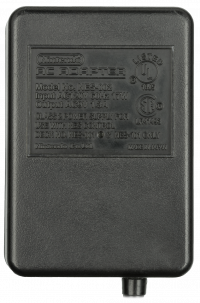
| |
| Nintendo Entertainment System (PAL) * | 9V AC | 1.2 A | ? | ? | N/A | NES-002 | WSU090-1300-13 or WSU090-1300-R13 | 5.5 x 2.5 mm barrel jack | External | The NES will accept a DC power supply so long as the voltage and current are within spec | ||
| Famicom * | 10V DC | 850 mA | 6.3 W | 1.4 W | Tip negative | HVC-002 | WSU090-1300-R | 5.5 x 2.1 mm barrel jack | External | 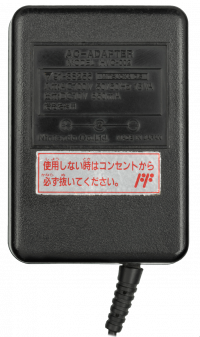
| ||
| AV Famicom * | 10V DC | 850 mA | 6.5 W | 1.2 W | Tip negative | HVC-002 | WSU090-1300-R | 5.5 x 2.1 mm barrel jack | External | 
| ||
| Famicom Disk System * | 9V DC | 400 mA | ? | ? | Tip negative | HVC-025 | WSU090-1300-R | 5.5 x 2.1 mm barrel jack | External or six internal C-cell batteries | With a splitter it should be possible to run both a Famicom and Disk System from a single AC adapter without batteries; the WSU-090-2000-R is recommended for this | ||
| Twin Famicom * | 7.6V DC | 1.25 A | ? | ? | Tip positive | UADP-0041CEZZ | WSU075-1500-13 | 5.5 x 2.5 mm barrel jack | External | Please note that the Twin Famicom's power circuitry is very sensitive to input voltage, anything higher than 7.6V causes the power transistor to run very hot | ||
| Sega SG-1000 * | 9V DC | 850 mA | 12.6 W | 2.4 W | Tip negative | SA-150 | WSU090-1300-R | 5.5 x 2.1 mm barrel jack | External | |||
| Sega SG-1000 II * | 9V DC | 850 mA | 9.5 W | 2.4 W | Tip negative | SA-150 | WSU090-1300-R | 5.5 x 2.1 mm barrel jack | External | |||
| Sega Mark III * | 9V DC | 850 mA | 8.6 W (no FM Sound Unit) 9.5 W (with FM Sound Unit) |
2.3 W | Tip negative | SA-150 | WSU090-1300-R | 5.5 x 2.1 mm barrel jack | External | |||
| Sega Master System * | 9V DC | 1 A | ? | ? | Tip negative | 3025 | WSU090-1300-R | 5.5 x 2.1 mm barrel jack | External | Different styles of this AC adapter exist, but all have the same specs and part number | ||
| Sega Master System (JP, MK-2000) * | 9V DC | 850 mA | 8.9 W | 2.4 W | Tip negative | SA-150 | WSU090-1300-R | 5.5 x 2.1 mm barrel jack | External | Different styles of this AC adapter exist, but all have the same specs and part number | ||
| Atari 7800 | 9V DC | 1 A | ? | ? | N/A, connector is keyed | CO24471-001 | ? | Two-pin keyed connector | External | Different styles of this AC adapter exist, but all have the same specs and part number | 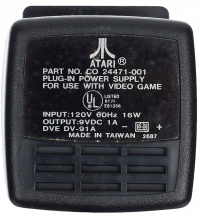
| |
| Casio PV-1000 * | 15V DC | 500 mA | ? | ? | Tip negative | AD-4815 | WSU150-0560-R | 5.5 x 2.1 mm barrel jack | External | 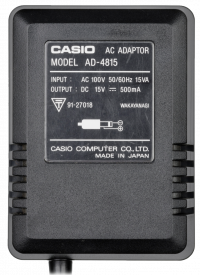
| ||
| Epoch Super Cassette Vision * | 8.5V DC | 800 mA | ? | ? | Tip negative | N/A | WSU090-1300-R | 5.5 x 2.1 mm barrel jack | External | |||
| Amstrad GX4000 * | 11V DC | 500 mA | ? | ? | Tip positive | GX4000PSU/UK (UK), GX4000PSU/E (EU) | WSU090-1300 | 5.5 x 2.1 mm barrel jack | External |
Fourth generation of consoles
| Console | Voltage | Amps | Avg Power
Draw (On) |
Avg Power
Draw (Off) |
Polarity | Original PN | Replacement PN | Connection | Power Supply | Notes | Confirmed by | Image |
|---|---|---|---|---|---|---|---|---|---|---|---|---|
| Atari Lynx * | 9V DC | 1A | ? | ? | Centre positive | C103891-001 | WS2U090-1300 | Barrel size 3.5mm x 1.35mm | External | Users need a 9V 1.3A center-positive TRIAD with a 2.1mm or 2.5mm inner diameter barrel (depending on the adapter barrel they purchase), as well as a "5.5mm x 2.1mm Female to 3.5mm x 1.35mm Male" Plug Socket DC Power Adapter. The console can also be powered by six AA batteries. | TheRealOC | 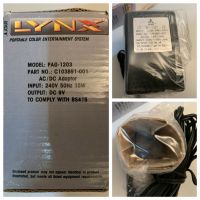
|
| NEC TurboGrafx 16 * | 10.5V DC | 730 mA | ? | ? | Tip negative | HES-ACA-01 | WSU090-1300-R | 5.5 x 2.1 mm barrel jack | External | 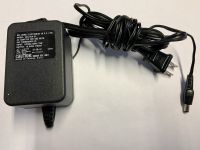
| ||
| PC Engine * | 9V DC | 650 mA | ? | ? | Tip negative | PAD-105/PAD-106 | WSU090-1300-R | 5.5 x 2.1 mm barrel jack | External | Same information also applies to both Core Grafx models and the PC Engine Shuttle | ||
| NEC PC Engine CD * | 9V DC | 1.45 A | ? | ? | Tip negative | AD-IF30/AD-IF30A | WSU090-2000-R13 | 5.5 x 2.5 mm barrel jack | External | Note that this is for the IFU-30 interface; the CD player portion (CDR-30) uses the same AC adapter as the PC Engine console when used as a standalone CD player | ||
| NEC TurboGrafx-CD * | 11V DC | 1.53 A | ? | ? | Tip negative | HES-ACA-02 | WSU120-2000-R13 | 5.5 x 2.5 mm barrel jack | External | Note that this is for the dock; the CD player portion (HES-CDR-01) uses the same AC adapter as the TG-16 console when used as a standalone CD player. Also note that the TG-CD dock will not power up properly with anything less than 10V, and the CD player will not read discs when docked | ||
| NEC SuperGrafx | 9V DC | 800 mA | ? | ? | Tip positive | PAD-113 | ? | 6.3 x 3.0 mm barrel jack | External | |||
| NEC TurboExpress/PC Engine GT | 7V DC | 700 mA | ? | ? | Tip positive | HES-ACA-04 (US), PAD-121 (JP) | ? | 3.5 x 1.35 mm barrel jack | External or six internal AA-cell batteries | |||
| NEC TurboDuo/PC Engine Duo | 10V DC | 1 A | ? | ? | Tip positive | HES-ACA-05 (US), PAD-124 (JP) | ? | 6.3 x 3.0 mm barrel jack | External | NEC also released an external battery pack for the Duo in Japan only | ||
| NEC Super CD-ROM2 | 12V DC | 1 A | ? | ? | Tip positive | PAD-125 | ? | 6.3 x 3.0 mm barrel jack | External | The Super CD-ROM2 also has a jumper cable which passes through power to the connected PC Engine console. This cable plugs into a 3.5 mm x 1.35 mm barrel jack on the Super CD and then into the power jack on the PC Engine. | ||
| NEC PC Engine LT | 9V DC | 700 mA | ? | ? | Tip positive | PAD-127 | ? | ? | External | ? | ||
| NEC PC Engine Duo-R/Duo-RX | 9V DC | 1 A | ? | ? | Tip positive | PAD-129/PAD-130 | ? | EIAJ-03 barrel jack | External | |||
| Sega Genesis (model 1) * | 9V DC | 1.2 A | ? | ? | Tip negative | MK-1602 | WSU090-1300-R | 5.5 x 2.1 mm barrel jack | External | |||
| Sega Mega Drive (model 1) * | 9V DC | 1.2 A | 17 W (VA0) | 3.7 W (VA0) | Tip negative | SA-160 (JP) | WSU090-1300-R | 5.5 x 2.1 mm barrel jack | External | |||
| Sega Genesis (model 2) | 10V DC | 850 mA | 8.4 W (VA2.3) 6.2 W (VA4) |
2.8 W | Tip positive | MK-2103 (US), SA-190 (JP) | ? | EIAJ-03 barrel jack | External | |||
| Sega Genesis 3 | 10V DC | 300 mA | ? | ? | Tip positive | MK-1479 | ? | EIAJ-03 barrel jack | External | |||
| Sega Mega Jet | 10V DC | 850 mA | 5.1 W | 2.8 W | Tip positive | SA-190 | ? | EIAJ-03 barrel jack | External | ? | ||
| Sega Genesis Nomad | 10V DC | 850 mA | ? | ? | Tip positive | MK-2103 | ? | EIAJ-03 barrel jack | External or six AA-cell batteries via clip-on pack or rechargeable battery via clip-on pack | ? | ||
| Sega 32X | 10V DC | 850 mA | ? | ? | Tip positive | MK-2103 (US), SA-190 (JP) | ? | EIAJ-03 barrel jack | External | Exactly the same as the model 2 Genesis/Mega Drive | ||
| Sega/Victor Wondermega RG-M1 | 9.5V DC | 1.5 A | ? | ? | Tip positive | AA-S95 | ? | EIAJ-03 barrel jack | External | |||
| Sega CDX | 9.5V DC | 1.5 A | ? | ? | Tip positive | MK-4122 | ? | EIAJ-03 barrel jack | External | Do not use the MK-2103 AC adapter as it does not supply enough current | ||
| JVC X'Eye/Victor Wondermega RG-M2 | 9.5V DC | 1.5 A | ? | ? | Tip positive | AA-S95 (JP), AA-S95J (US) | ? | EIAJ-03 barrel jack | External | Same specs as the CDX AC adapter; as with the CDX do not use the MK-2103 AC adapter as it does not supply enough current | ||
| Sega Game Gear * | 9V DC (JP/EU), 10V DC (US) | 850 mA or 1.2 A (JP), 850 mA (US), 1.2 A (EU) | 5.7 W (two ASIC model) | 2.8 W | Tip negative (EU/JP), tip positive (US) | SA-150 or SA-160 (JP), 2103/MK-2103 (US), 1605 (EU) | WSU090-1300-R (EU/JP) | 5.5 x 2.1 mm barrel jack (EU/JP), EIAJ-03 barrel jack (US) | External or six internal AA-cell batteries | European and Japanese Game Gears use the same AC adapter as the model 1 Mega Drive, whereas (for some reason) US models use a different AC adapter which was later used for the model 2 Genesis/Mega Drive | ||
| Nintendo Game Boy | 4.8V DC | 150 mA | ? | ? | Tip negative | DMG-003 | ? | ? | External or four internal AA-cell batteries | Also doubles as a rechargeable battery pack | ||
| Nintendo Game Boy Pocket | 3V DC | 300 mA | ? | ? | Tip positive | MGB-005 | ? | ? | External or two internal AAA-cell batteries | ? | ||
| Super Nintendo (US) | 10V DC | 850 mA | ? | ? | Tip negative | SNS-002 | ? | 6.9 mm x 4.1 mm barrel jack with 0.7 mm inner pin | External | 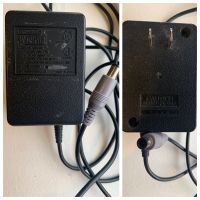
| ||
| Super Famicom * | 10V DC | 850 mA | 6.8 W (SHVC-CPU-01) 6.2 W (SNS-CPU-1CHIP-01) |
1.2 W | Tip negative | HVC-002 | WSU090-1300-R | 5.5 x 2.1 mm barrel jack | External | Exactly the same as the original Famicom | 
| |
| Super Nintendo (PAL) * | 9V AC | 1.2 A | ? | ? | Not applicable | NES-002 | ? | 5.5 x 2.5 mm barrel jack | External | Exactly the same as the PAL NES; the PAL SNES has a charge pump circuit which generates 12V DC for SCART autoswitching, hence the use of an AC power supply | ||
| SNK Neo Geo AES * | 5V DC (PRO-POW models only), 10V DC (PRO-POW3/E models only) | 3 A (5V), 1 A (10V) | ? | ? | Tip negative | PRO-POW (5V) NEO-POW3 (10V) | WSU050-3000-R (5V), WSU090-1300-R (10V) | 5.5 x 2.1 mm barrel jack | External | Older AES consoles used a regulated 5V DC AC adapter while newer models had an unregulated 10V supply. Be *very* careful! | ||
| SNK Neo Geo CD | 5V DC, 12V DC | 2 A (5V), 1 A (12V) | ? | ? | N/A, connector is keyed | POWCD-J (JP) | N/A | Three-pin connector, same as found on some Panasonic and Sony MSX2 models (though not the same pinout!) | External | ? | 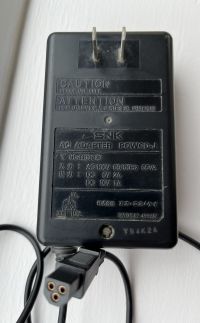
| |
| Pioneer LaserActive | Input: 100V AC (JP), 120V AC (US) | ? | ? | ? | N/A, power cord is hardwired | N/A | N/A | N/A | Internal | ? |
Fifth generation of consoles
| Console | Voltage | Amps | Avg Power
Draw (On) |
Avg Power
Draw (Off) |
Polarity | Original PN | Replacement PN | Connection | Power Supply | Notes | Confirmed by | Image |
|---|---|---|---|---|---|---|---|---|---|---|---|---|
| Commodore Amiga CD32 | 5V DC, 12V DC | ? | ? | ? | N/A | ? | ? | 4-pin DIN | External | ? | ||
| Panasonic 3DO | ? | ? | ? | ? | ? | ? | ? | ? | ? | ? | ||
| Atari Jaguar * | 9V DC | 1.2 A | ? | ? | Tip negative | 500273/PP-912 | WSU090-1300-R | 5.5 x 2.1 mm barrel jack | External | 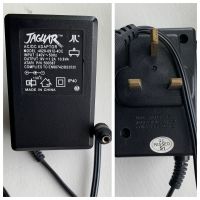
| ||
| Atari Jaguar CD * | 9V DC | 1.2 A | ? | ? | Tip negative | 500273/PP-912 | WSU090-1300-R | 5.5 x 2.1 mm barrel jack | External | Exactly the same as the Jaguar itself | ||
| Bandai Playdia * | 9V DC | 850 mA | ? | ? | Tip positive | BA-002 | WSU090-1300 | 5.5 x 2.1 mm barrel jack | External | |||
| Sega Saturn | ? | ? | ? | ? | N/A | ? | ? | C7 | Internal | North American consoles have a polarized connector | ||
| Sony PlayStation | ? | ? | ? | ? | N/A | ? | ? | C7 | Internal | North American consoles have a polarized connector | ||
| Sony PSone | 7.5V DC | 2 A | 5.5 to 7 W (no LCD) 12.2 to 15 W (with LCD) |
0.7 W (no LCD) 2.1 W (with LCD) |
Tip positive | SCPH-112 (JP), SCPH-113 (US), SCPH-114 (EU), SCPH-115 (UK) | ? | EIAJ-03 barrel jack | External | Do not use a PS2 slim AC adapter! | ||
| NEC PC-FX | Input: 100V AC | ? | ? | ? | N/A, power cord is hardwired | ? | N/A | N/A | Internal | |||
| Casio Loopy | 24V DC | 1 A | ? | ? | Tip positive | AD-2410J | ? | 5.5 x 2.5 mm barrel jack | External | ? | ||
| Apple Pippin | Input: 100-240V AC | ? | ? | ? | N/A | ? | N/A | C14 | Internal | |||
| Nintendo 64 | 3.3V DC, 12V DC | 2.7 A (3.3V), 0.8 A (12V) | 7 W (with Expansion Pak) | 0.8 W (with Expansion Pak) | N/A, entire power supply is designed to only fit one way into the console itself | NUS-002 | ? | Proprietary connector | External |
Sixth generation of consoles
| Console | Voltage | Amps | Avg Power
Draw (On) |
Avg Power
Draw (Off) |
Polarity | Original PN | Replacement PN | Connection | Power Supply | Notes | Confirmed by | Image |
|---|---|---|---|---|---|---|---|---|---|---|---|---|
| Game Boy Advance | 3.3V DC | 350 mA | ? | ? | N/A, connector is molded to only fit one way into the system | AGB-009 | ? | N/A, fits into battery bay | External or two internal AA-cell batteries | The original GBA does not have a dedicated AC adapter input like other Game Boy systems, all external AC adapters use the battery terminals | ||
| Game Boy Advance SP | 5.2V DC | 320 mA | N/A, system cannot be powered on without the battery | 2.3 W (AGS-101) | N/A, connector is keyed | AGS-002 | Unofficial 5 V USB cables | Proprietary connector | External | |||
| Game Boy Micro | 5.2V DC | 320 mA | ? | ? | N/A, connector is keyed | OXY-002 | Unofficial 5 V USB cables | Proprietary connector | External | |||
| Sega Dreamcast | Input: 100V AC (JP), 120V AC (US), 220/240V AC (EU/UK); Output: 3.3V DC, 5V DC, 12V DC | ? | ? | ? | ? | ? | N/A | C7 | Internal | North American consoles have a polarized connector | ||
| Sony PlayStation 2 (original) | Input: 100V AC (JP), 120V AC (US), 220/240V AC (EU/UK); Output: 12V DC | 28.5 to 34 W (SCPH-37000) | 2.3 W (SCPH-37000) | ? | ? | ? | C7 | Internal | North American consoles have a polarized connector | |||
| Sony PlayStation 2 (slim, SCPH-7xxxx) | Input: 100V-240V AC; Output: 8.5V DC | Input: 1.5 A, Output: 5.65 A | ~16 W (PS2 game) ~15.5 W (PS1 game) |
0.7 W | Tip positive | SCPH-70100 | ? | EIAJ-03 barrel jack | External | 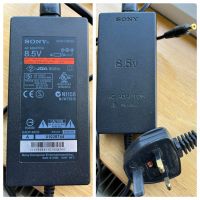
| ||
| Sony PlayStation 2 (slim, SCPH-9000x) | Input: 100-240V AC; Output: 7.5V DC | Output: 4.5 A | ? | ? | N/A | ? | ? | C7 non-polarized | Internal | Power supply is multivoltage despite what is indicated on the outside of the console | ||
| VM Labs Nuon | Input: 120V AC | ? | ? | ? | N/A, power cord is hardwired | ? | ? | N/A | Internal | ? | ||
| Microsoft Xbox | ? | ? | ? | ? | ? | ? | ? | C7 non-polarized | Internal | |||
| Nintendo GameCube | 12V DC | 3.25 A | ? | ? | N/A, connector is keyed | DOL-002 | ? | Proprietary connector | External | 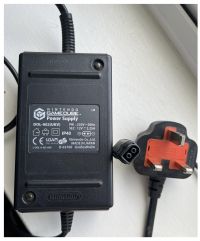
|
Seventh generation of consoles
| Console | Voltage | Avg Power
Draw (On) |
Avg Power
Draw (Off) |
Amps | Polarity | Original PN | Replacement PN | Connection | Power Supply | Notes | Confirmed by | Image |
|---|---|---|---|---|---|---|---|---|---|---|---|---|
| Nintendo DS | 5.2 V DC | ? | ? | 320 mA | N/A, connector is keyed | AGS-002 | Unofficial 5 V USB cables | Proprietary connector | External | Same as GBA SP except for console name removed from sticker | ||
| Nintendo DS Lite | 5.2 V DC | ? | ? | 450 mA | N/A, connector is keyed | USG-002 | Unofficial 5 V USB cables | Proprietary connector | External | Resembles Mini-USB B to the point a mangled connector can be directly and "correctly" connected | ||
| Nintendo DSi series | 4.6 V DC | ? | ? | 900 mA | N/A, connector is keyed | WAP-002 | Still unofficially USB compatible | Proprietary connector | External | Originally invented for Nintendo/Buffalo WAP-001 Wi-Fi access point | ||
| Sony PSP (except N1000/Go) | 5 V DC | ? | ? | EP: 1500 mA, LP: 2000 mA | Negative ground | PSP-100 (two piece), PSP-103 (fixed cable) | Third party USB-based cables; official USB charging (if console can boot, not on 1000 series) | EIAJ-02 (4.0/1.7 mm barrel) | External | |||
| Sony PSP-N1000 series (Go) | 5 V DC | ? | ? | 1500 mA | USB-A | PSP-N100 (laptop style three piece), PSP-N104 (wall wart two piece) | PC/generic USB power supply? | Electrically USB-A, but in recessed position requiring a long and specially notched plug | External | |||
| Nintendo Wii | 12V DC | 16 W[8] (WiFi on or off) | 9 W,
1.9 W (WiFi on) |
3.7 A | N/A, connector is keyed | RVL-002 | ? | Proprietary connector | External | |||
| Mattel HyperScan | ? | ? [8] | ? | ? | ? | ? | ? | ? | ? | ? | ? | ? |
| Microsoft Xbox 360 (Xenon/Zephyr) | Output: 12V DC, 5V DC | 172 W[8] | 2.2 W | 16.5 A (12V), 1 A (5V) | N/A, connector is keyed | DPSN-186CB-1A | ? | Proprietary connector with central and overline tabs | External | Forwards compatible | 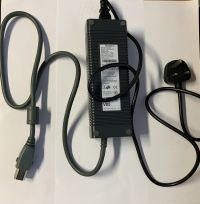
| |
| Microsoft Xbox 360 (Falcon/Opus) | Output: 12V DC, 5V DC | ? | ? | 14.2 A (12V), 1 A (5V) | N/A, connector is keyed | ? | ? | Proprietary connector with overline tab | External | Forwards compatible | ||
| Microsoft Xbox 360 (Jasper/Kronos) | Output: 12V DC, 5V DC | ? | ? | 16.5 A (12V), 1 A (5V) | N/A, connector is keyed | ? | ? | Proprietary connector with split overline tabs | External | |||
| Microsoft Xbox 360 S | Output: 12V DC, 5V DC | 88 W[8] | 0.7 W | 9.6 A (12V), 1 A (5V) | N/A, connector is keyed | PB-2121-03MX | ? | Proprietary double barrel jack connector | External | ? | ||
| Microsoft Xbox 360 E | Output: 12V DC, 5V DC | ? | ? | 9.6 A (12V), 1 A (5V) | N/A | DCGP FJ-1 | ? | Proprietary barrel jack connector | External | ? | ||
| Sony PlayStation 3 | Input: 100V-240V AC (most models), 220V-240V AC (early PAL models) | 189 W (early models)[8]76.3 W (43XX)[9] | 1.1 W | ? | ? | ? | ? | C14 (original models), C7 non-polarized (Slim and Super Slim models) | Internal | Detailed information can be found here. | ||
| Sony PlayStation 3 standard controller/keyboard/headset | 5 V | ? | ? | 2x 500 mA | USB-A | CECHZA1 | PS3 console, compatible (handshaking) USB hosts | C7 to two USB-A | External | |||
| Sony PlayStation 3 Move controller | 5 V | ? | ? | ? | ? | CECH-ZCC1 | ? | Barrel jack, unspecified | External |
Eighth generation of consoles
| Console | Voltage | Amps | Avg Power
Draw (On) |
Avg Power
Draw (Off) |
Avg Power
Draw (Standby) |
Polarity | Original PN | Replacement PN | Connection | Power Supply | Notes | Confirmed by | Image |
|---|---|---|---|---|---|---|---|---|---|---|---|---|---|
| Nintendo 3DS/2DS Series incl. New | 4.6 V DC | 900 mA | ? | ? | ? | N/A, connector is keyed | WAP-002 | Still unofficially USB compatible | Proprietary connector | External | Eventually replaced with cost-cutting revision (thinner cable) | ||
| Sony PS Vita | 5 V DC | 1 A (?) | ? | ? | ? | USB-A | PCH-ZAC1 | Official USB charging | Electrically USB-A, but in recessed position requiring a long and specially notched plug | External | Connects to model specific data cable (1000 series: proprietary, 2000 series: micro-USB B) | ||
| Sony PS Vita TV | 5 V DC | 2000 mA | ? | ? | ? | Negative ground | PDEL-100 | PSP power bricks and their equivalents | EIAJ-02 (4.0/1.7 mm barrel) | External | Recycled from developer Vita | ||
| Nintendo Wii U | 15V DC | 5 A | 34 W[10] | 0.4 W | 0.4 W | N/A, connector is keyed | WUP-002 | ? | Proprietary connector | External | Connector is very similar to the original Wii but is not compatible (colored yellow for identification). Unofficially[11] multivoltage. | ||
| Nintendo Wii U GamePad | 4.75 V DC | 1.6 A | ? | ? | ? | N/A, connector is keyed | WUP-011 | Still unofficially USB compatible | Proprietary connector | External | Just barely enlarged 2/3DS/i/XL connector. Unofficially multivoltage. | ||
| Sony PlayStation 4 (original) | Input: 100-240V AC | ? | 95.1 W (12XX)
115.1 W (11XX) 137.3 W (1016A)[9] |
0.3 W | 5.2 W (12XX)
7.3 W (11XX) 7.8 W (1016A) |
? | ? | ? | C7 non-polarized | Internal | |||
| Sony PlayStation 4 (slim) | Input: 100-240V AC | ? | 78.2 W (22XX)
75.2 W (21XX) 82.8 W (20XX)[9] |
0.2 W | 5.4 W (22XX)
5.8 W (21XX) 5.5 W (20XX) |
? | ? | ? | C7 non-polarized | Internal | |||
| Sony PlayStation 4 Pro | Input: 100-240V AC | ? | 126 W (70XX)
139 W (71XX) 146 W (72XX)[12] |
0.2 W | 8.2 W (70XX)
7.4 W (71XX) 6.4 W (72XX) |
? | ADP-300CR / ADP-300ER / ADP-300FR | ? | C17 (CUH-7000 and -7100 models), C7 non-polarized (CUH-7200 models) | Internal | The PS4 Pro has an internal power supply module, which can be accessed once the console is disassembled. Some revisions connected to an electrical outlet using a PC lead, while some used a Figure 8 AC cord. | 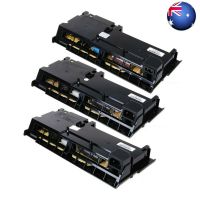
| |
| Microsoft Xbox One | Input: 100-127V AC (JP/US), Output: 12V DC, 5V DC | 16.5 A (12V), 1 A (5V) | 112 W[10] | 0.4 W | 15.7 W | PB-2201-02MX | ? | ? | Proprietary connector, same as the 360 S | External | |||
| Microsoft Xbox One S | Input: 100-240V AC | ? | 62 W[13] | 0.5 W | 11 W | ? | ? | ? | C7 non-polarized | Internal | |||
| Microsoft Xbox One X | Input: 100-240V AC | ? | 100-172 W[14] | <1 W | 10 W | ? | ? | ? | C7 non-polarized | Internal | |||
| Nintendo Switch | Input: 100-240V AC, Output: 5V DC, 15V DC | 1.5A (5V), 2.6A (15V) | 7 W (original)
6 W (OLED)[15] |
0.3-0.5 W | 0.3-0.5 W | N/A, connector is reversible | HAC-002 | ? | USB-C | External | Not fully USB-PD compliant. Compatible 15V power supply required for dock. |
Ninth generation of consoles
| Console | Voltage | Amps | Avg Power Draw (On) | Avg Power Draw (Off) | Avg Power Draw (Standby) | Polarity | Original PN | Replacement PN | Connection | Power Supply | Notes | Confirmed by | Image |
|---|---|---|---|---|---|---|---|---|---|---|---|---|---|
| Sony PlayStation 5 | Input: 100-240V AC; Output: 12V DC | Output: 31 A | 200 W[9] | 1.3 W | 3.2 W | N/A | ADP-400DR | N/A | C7 non-polarized | Internal | The ADP-400DR is an internal power supply module, which can be accessed once the console is disassembled. To connect to an electrical outlet, the PS5 uses a standard Figure 8 AC cord. | 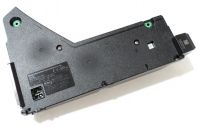 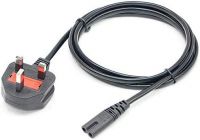
| |
| Sony PlayStation 5 Digital Edition | Input: 100-240V AC; Output: 12V DC | Output: 31 A | 200 W[9] | 1.3 W | 3.8 W | N/A | ADP-400DR | N/A | C7 non-polarized | Internal | The ADP-400DR is an internal power supply module, which can be accessed once the console is disassembled. To connect to an electrical outlet, the PS5 uses a standard Figure 8 AC cord. |  
| |
| Microsoft Xbox Series S | Input: 100-240V AC; Output: 12V DC | Input: 2.3 A; Output: 13.75 A | 74 W[13] | 0.4 W | 10 W | N/A | 1921 | M1111343-001 | C7 non-polarized | Internal | The Series S uses an internal power supply module, manufactured by LiteOn, which can be accessed once the console is disassembled. To connect to an electrical outlet, the console uses a standard Figure 8 AC cord | 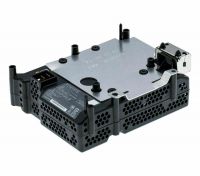 
| |
| Microsoft Xbox Series X | Input: 100-240V AC; Output: 12V DC | Input: 4.5 A (100-127V), 2.3 A (200-240V); Output: 21.25 A | 153 W[13] | 0.5 W | 13 W | N/A | 1920 | M1109865-006 | C7 non-polarized | Internal | The Series X uses an internal power supply module, manufactured by LiteOn, which can be accessed once the console is disassembled. To connect to an electrical outlet, the console uses a standard Figure 8 AC cord | 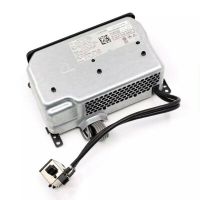 
|
References
- ↑ https://shmup.fandom.com/wiki/Tate_Mode
- ↑ https://www.doesitflip.com/
- ↑ https://shmups.system11.org/viewtopic.php?f=1&t=60868
- ↑ https://store.steampowered.com/curator/14416124/
- ↑ https://retronauts.com/article/946/the-comprehensive-list-of-flip-grip-friendly-vertical-games-for-switch
- ↑ http://www.gamepilgrimage.com/content/games-tate-mode-standard-definition
- ↑ https://www.reddit.com/r/NintendoSwitch/comments/85fqso/list_of_switch_games_that_support_nonstandard/
- ↑ 8.0 8.1 8.2 8.3 8.4 https://www.cmu.edu/ceic/assets/docs/publications/working-papers/ceic-11-01.pdf
- ↑ 9.0 9.1 9.2 9.3 9.4 https://www.playstation.com/en-gb/legal/ecodesign/
- ↑ 10.0 10.1 https://www.nrdc.org/sites/default/files/video-game-consoles-IP.pdf
- ↑ [1]
- ↑ https://www.eurogamer.net/playstation-5-review-digitalfoundry
- ↑ 13.0 13.1 13.2 https://web.archive.org/web/20221118134519/https://support.xbox.com/en-US/help/hardware-network/power/learn-about-power-modes
- ↑ https://www.anandtech.com/show/11992/the-xbox-one-x-review/6
- ↑ https://www.nintendo.co.uk/Corporate/Consumer-Information/Eco-design/Information-about-energy-efficiency-and-eco-design-of-Nintendo-Switch-family-consoles-2026830.html